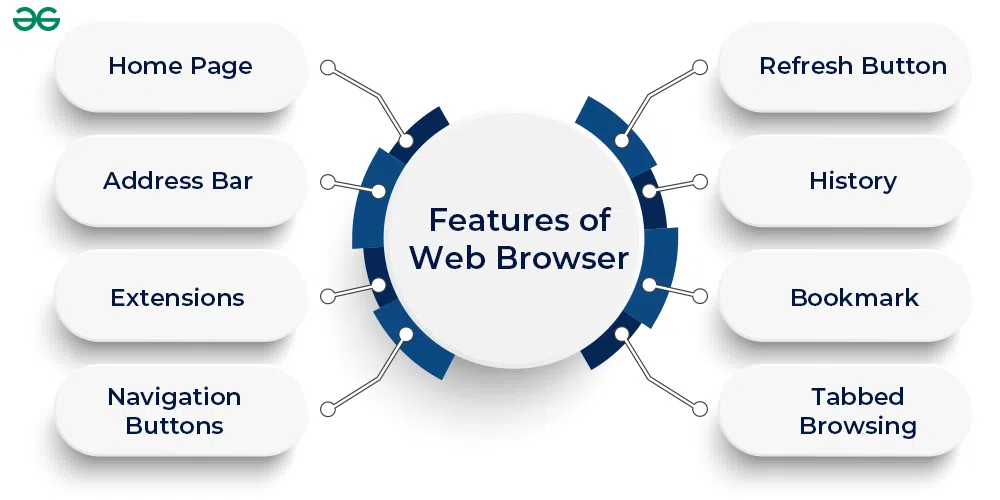Functions and Features of a Web Browser
Last Updated :
13 Sep, 2023
What is a Web Browser?
In simple words, a web browser is an application through which we can access websites on the World Wide Web (www). It provides users a medium using which they can interact with a web server as it fetches the data and displays it as a web page. We always use Chrome for browsing websites in our daily lives. Well, Chrome is one of the most popularly used web browsers.
In today’s time, there are various different web browsers available. Each web browser has some unique characteristics and is distinguished depending on features like speed, security, extensions, etc. Right now, Google Chrome is the most used browser in the world, however, there are some other popular browsers being used like Mozilla Firefox, Opera, Microsoft Edge, etc.
Functions of a Web Browser
A web browser is a medium through which you can basically access different websites.
- The main function of a web browser is to provide an interface to the user for sending requests and fetching data/information from the web servers.
- It also displays the information to the user including multimedia elements (images and videos) in the form of webpages, using CSS and JavaScript.
- A web browser acts as a platform to access various websites. Users can visit different websites by just entering the URL of the website on the web browser.
- Browsers also have navigation features like a navigation bar, tabs, and other tools which make surfing the net easier. One can also open multiple web pages at the same time, reload, and navigate forward and backward between web pages.
- Another function of web browsers is to ensure secure and safe access to websites. This is accomplished by pop-up warnings, scanning for malicious software and other safety measures.
- The functionality of browsers can also be improved by adding extensions or plugins to the browser. Most commonly installed extensions include AdBlock, Calendar and other constructive tools.
- The data accessed by a user frequently is stored by the web browsers in the form of cache. This saves the loss of data and time while accessing the data again and again.

Features of Web Browser
A web browser consists of several features which provide a user-friendly environment in a browser. Some of the features are listed below:
- Home Page: Whenever we open a browser, the first web page which loads is called the home page. Although the home page of a browser has some default setting, it can be changed according to user’s preference.
- Address (URL) Bar: The URL of the website that has to be accessed is entered here. Through this bar user can access different websites or search anything on browser.
- Navigation Buttons: Using the forward and backward buttons user can revisit previously opened web pages. These buttons provide convenience to retrieve data previously accessed.
- History: If you visited a website and want to revisit it after a few days but have forgotten the address of website then don’t worry as every browser has a history where it collects all previously visited data. This is a very handy feature to revisit websites.
- Bookmark: This feature helps in quickly accessing websites. If you come across some important web page you can always bookmark it for easy access in future.
- Refresh Button: The refresh button reloads the page and shows updates if any.
- Home Button: It brings the user to home page which can be set by user.
- Tabbed Browsing: Using this feature a user can open multiple web pages in the same web browser so that they can easily switch between them.
- Extensions: Extensions or plugins (like AdBlock) can be installed by the user. These extensions help in improving functionality of web browsers.

These are some of the basic features you will find in most of the browsers. Let’s look into a few unique features of the most popularly used web browsers
Chrome:
Chrome is the most used web browser because of its attractive browsing features. One of them is that it has made accessing data from any device convenient. This is possible as it allows to sync user’s browsing data, passwords, history by logging with their Google account. Apart from this chrome also provides faster speed and easy to use interface.
Mozilla Firefox:
Mozilla Firefox provides a wide library of add-ons or extensions and also allows to customize the interface of the browser to a great extent. Along with this, Mozilla Firefox pays special attention to user’s privacy policies.
Opera:
It is the first Chromium-based browser that uses a Multithreaded Compositor. It has a built-in VPN feature which is useful in maintaining user’s privacy.
Safari:
Safari has adopted all the possible measures to protect the user’s data and information. It includes a private browsing mode,offline reading list, intelligent tracking prevention, a customizable start page, supports gestures for easy navigation to ensure great user interface experience.
Microsoft Edge:
You might find Edge pre-installed in Windows 10 and 11 devices. It also has user friendly interface and is integrated with other Microsoft services. Other features like collections and web capture are causing its popularity gain.
By now we can understand how a web browser’s features and functions provide users a quick and easy access to different web pages across the browser.
Share your thoughts in the comments
Please Login to comment...